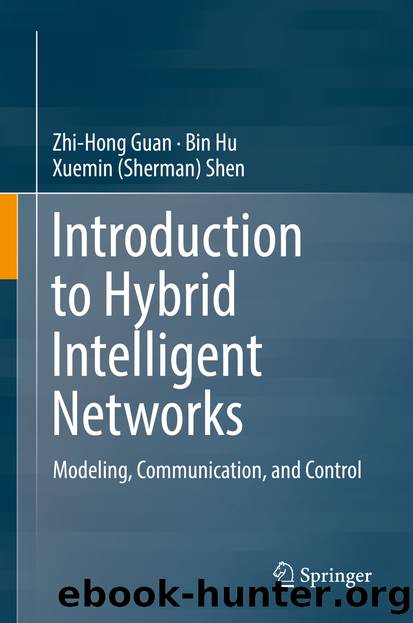Introduction to Hybrid Intelligent Networks by Zhi-Hong Guan & Bin Hu & Xuemin (Sherman) Shen

Author:Zhi-Hong Guan & Bin Hu & Xuemin (Sherman) Shen
Language: eng
Format: epub
ISBN: 9783030021610
Publisher: Springer International Publishing
Fig. 5.4Chaotic behaviors and synchronization of four-dimensional NNs (5.27): Example 5.2, τ a = 0.12. (a) Chaotic trajectories of single NN: x i1 and x i2. (b) Chaotic trajectories of single NN: x i3 and x i4. (c) State trajectories of interconnected NNs: x i1 and x i2. (d) State trajectories of interconnected NNs: x i3 and x i4. (e) Long-term state trajectories of interconnected NNs: x i1 and x i2. (f) Long-term state trajectories of interconnected NNs: x i3 and x i4
In this example, the coupling matrix G, the nonlinear protocol (5.4), and the randomized broadcast impulse (5.6) are as given in Example 5.1. Choosing ω k = 3.5, one gets β k = 1.0417 in (5.17). The randomized impulse (5.29) is then an impulsive perturbation. Similarly for condition (5.18), one has α 2 = 2.8371 and α = 4.4190. Since , β = 1.0417, τ a = 0.12, and , , then condition (5.19) holds. The initial states are randomly chosen: 5 ∗randn(12, 1). The impulsive state trajectories of NNs (5.27) are presented in Fig. 5.4c–f. The synchronization errors are compared in Fig. 5.5: impulse versus no-impulse, with T syn = 6.8451(s) and T syn0 = 1.2187(s). In particular, the state impulses of NNs (5.27) that given in Examples 5.1 and 5.2 are respectively shown in Fig. 5.6a and Fig. 5.6b, c.
Fig. 5.5Error comparison: perturbative impulse, Example 5.2
Download
This site does not store any files on its server. We only index and link to content provided by other sites. Please contact the content providers to delete copyright contents if any and email us, we'll remove relevant links or contents immediately.
| Antennas | Microwaves |
| Mobile & Wireless | Networks |
| Radar | Radio |
| Remote Sensing & GIS | Satellite |
| Signal Processing | Telephone Systems |
| Television & Video |
Whiskies Galore by Ian Buxton(40334)
Introduction to Aircraft Design (Cambridge Aerospace Series) by John P. Fielding(32339)
Small Unmanned Fixed-wing Aircraft Design by Andrew J. Keane Andras Sobester James P. Scanlan & András Sóbester & James P. Scanlan(32141)
Craft Beer for the Homebrewer by Michael Agnew(17447)
Turbulence by E. J. Noyes(7041)
The Complete Stick Figure Physics Tutorials by Allen Sarah(6640)
Kaplan MCAT General Chemistry Review by Kaplan(6054)
The Thirst by Nesbo Jo(5786)
Bad Blood by John Carreyrou(5770)
Learning SQL by Alan Beaulieu(5412)
Weapons of Math Destruction by Cathy O'Neil(5038)
Man-made Catastrophes and Risk Information Concealment by Dmitry Chernov & Didier Sornette(4738)
iGen by Jean M. Twenge(4702)
Digital Minimalism by Cal Newport;(4545)
Life 3.0: Being Human in the Age of Artificial Intelligence by Tegmark Max(4509)
Audition by Ryu Murakami(4099)
1,001 ASVAB Practice Questions For Dummies by Powers Rod(4040)
Electronic Devices & Circuits by Jacob Millman & Christos C. Halkias(4029)
Pale Blue Dot by Carl Sagan(4003)
